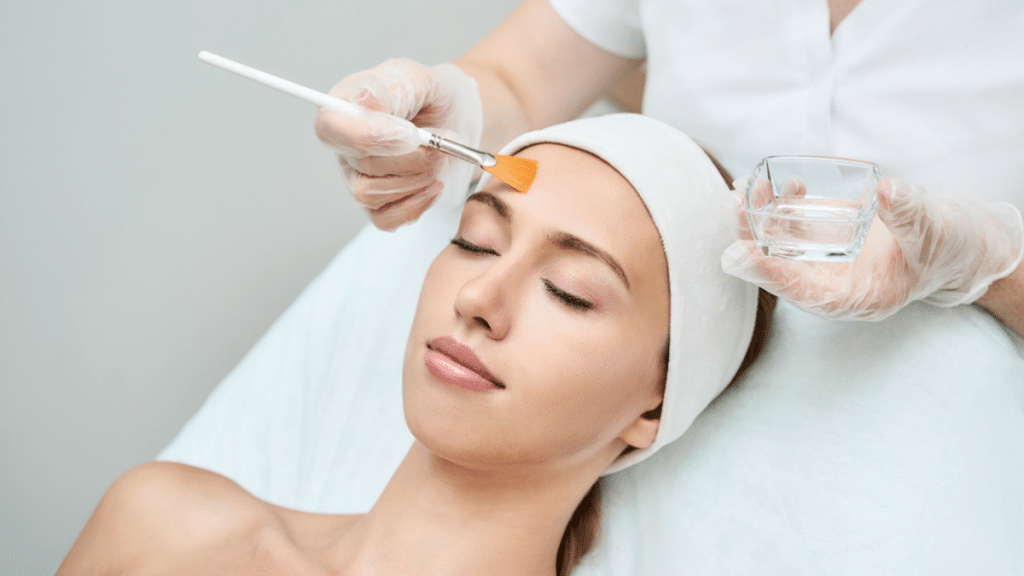When it comes to rejuvenating your skin, two powerful treatment options often come up: chemical peels and laser treatments. Both share the goal of addressing common skin concerns like aging, uneven texture, and pigmentation, but the choice between them depends on your specific skin needs, lifestyle, and desired results. Here’s an in-depth look to help you determine which option might be best for you.
Understanding Laser and Phototherapy Treatments
Lasers and phototherapy treatments have revolutionized aesthetic medicine by offering non-invasive or minimally invasive solutions for skin concerns. Utilizing targeted light energy, laser treatments can achieve results that were previously unattainable with traditional methods. These treatments interact with the skin’s chromophores (melanin, hemoglobin, water) to either heat, disrupt, or stimulate skin tissue, leading to improved texture, tone, and clarity.
Types of Laser and Phototherapy Treatments:
- Ablative Lasers (e.g., CO2 and Erbium YAG): Ideal for deep resurfacing, they target more significant wrinkles, scars, and pigmentation issues but come with more downtime.
- Non-Ablative Lasers (e.g., Nd, Diode): These penetrate the skin without damaging the outer layer, stimulating collagen production with minimal downtime.
- Fractional Lasers: Fractional lasers treat small portions of the skin at a time, promoting quicker healing and stimulating collagen production. Moxi, a non-ablative fractional laser, uses a 1927 nm wavelength to treat pigmentation, fine lines, and uneven skin texture. It’s an ideal option for “prejuvenation” or maintaining youthful skin with minimal downtime.
- Phototherapy (e.g., BBL): BroadBand Light (BBL) is a type of intense pulsed light (IPL) treatment that targets pigmented and vascular lesions and helps improve skin tone and texture. It’s non-invasive with minimal downtime, making it a great option for overall skin rejuvenation. BBL and Moxi are often used together for comprehensive skin treatments.
Benefits of Laser Treatments:
- Precision: Lasers offer precise control over the treatment area, allowing for targeted therapy without affecting surrounding tissue.
- Minimal Downtime (for some treatments): While ablative lasers require downtime, options like non-ablative lasers, including Moxi, and phototherapy such as BBL, have little to no downtime.
- Long-Lasting Results: Laser treatments, especially for wrinkles and scars, provide dramatic improvements with lasting effects(Laser and Phototherapy).
Understanding Chemical Peels
Chemical peels involve the application of a chemical solution that exfoliates and removes damaged outer skin layers, revealing fresher, smoother skin beneath. Chemical peels have been used since ancient times, dating back to Egyptians who used sour milk (lactic acid) for smoother skin. Today, they remain a staple in aesthetic treatments due to their versatility and effectiveness.
Types of Chemical Peels:
- Superficial Peels: Using AHAs or BHAs like glycolic or salicylic acid, these peels exfoliate the outermost layer of the skin to treat fine lines, acne, and texture issues with little downtime.
- Medium Peels: Agents like TCA penetrate deeper into the skin to address more prominent concerns such as moderate wrinkles, acne scars, and pigmentation(Chemical Peels).
- Deep Peels: Using phenol or high-strength TCA, these peels penetrate the dermal layers, offering powerful results but requiring significant downtime(Chemical Peels).
Benefits of Chemical Peels:
- Cost-Effective: Peels typically cost less than laser treatments, making them accessible for regular use.
- Safer for Darker Skin Tones: Peels carry less risk of post-inflammatory hyperpigmentation for individuals with darker skin tones compared to some laser treatments(Chemical Peels).
- Customizable: Peels can be tailored to your skin type and concerns, offering a wide range of intensity levels to address various issues from acne to deep wrinkles.
Which Treatment Should You Choose?
When to Choose Laser Treatments:
- Need for Precision: If you have specific areas you want to target, such as broken blood vessels or deeper pigmentation, laser treatments offer the precision needed for focused results.
- Desire for Long-Lasting Results: Laser treatments, especially with Moxi or fractional lasers, often provide more dramatic and longer-lasting improvements, particularly for deeper wrinkles, acne scars, and pigmentation issues.
- Minimal Downtime: If your lifestyle doesn’t allow for extended downtime, non-ablative laser treatments like Moxi or IPL treatments like BBL might be ideal since they allow you to resume normal activities almost immediately(Laser and Phototherapy).
When to Choose Chemical Peels:
- Budget-Friendly Option: Chemical peels tend to be more affordable, making them a great option for ongoing maintenance.
- Darker Skin Tones: For those with higher Fitzpatrick skin types, superficial and medium-depth peels are generally safer, reducing the risk of hyperpigmentation compared to some laser treatments(Chemical Peels).
- First-Time Treatment: If you’re new to skin resurfacing, a light peel like the ZO Stimulator Peel is a great introduction, offering noticeable results without downtime(Chemical Peels).
Final Considerations
Both chemical peels and laser treatments are effective ways to achieve rejuvenated, youthful-looking skin. The right choice depends on your skin type, concerns, and lifestyle. It’s always best to consult with your provider to develop a personalized treatment plan that addresses your needs.
At Allure Aesthetics, we offer both laser and chemical peel treatments to help you achieve your skin goals. Whether you’re interested in a quick, no-downtime peel, a non-ablative laser like Moxi, or a phototherapy session with BBL, we’ll work with you to select the option that best suits your skin.
